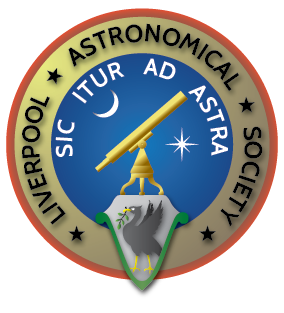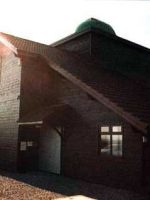HAPPY CHRISTMAS & CLEAR DARK SKIES FOR 2001
FROM ALL MEMBERS OF LIVERPOOL ASTRONOMICAL SOCIETY.
Society News Headlines
- Dec 1st: Moon is at apogee.
- Dec 1st: LAS Pex Hill Observatory Public Open Night 7:30pm – 9:30pm.
- Dec 2nd: Uranus 2° North of Moon.
- Dec 2nd: Comet C71/P (Clark) at Perihelion (1.559 AU)
- Dec 2nd: LAS Croxteth Park Public Weekend Star Party 2000 (Ends Dec 3rd).
- Dec 4th: Pluto in conjunction with the Sun.
- Dec 7th: 5th Anniviversary (1995) of Galileo spacecraft goes into orbit around Jupiter.
- Dec 8th: LAS Monthly meeting (Members Lecture Night) at RC Cathedral, Crypt Concert Room. 7pm – 9pm.
- Dec 9th: Saturn is 1.8° North of Moon.
- Dec 10th: Jupiter 3° North of Moon.
- Dec 11th: Mars 4° North of Spica.
- Dec 11th: Venus 3° South of Neptune.
- Dec 12th: Moon at perigee.
- Dec 13th: Geminids meteor shower maximum.
- Dec 13th: Comet C/1999 T1 (McNaught-Hartley) at Perihelion (1.172AU)
- Dec 20th: Mars 4° Spica.
- Dec 21st: Winter Soltice at (13:34 UTC).
- Dec 22nd: Ursids meteor shower maximum.
- Dec 23rd: Venus 1.3° South of Uranus.
- Dec 23rd: Ceres 0.9° South of Moon.
- Dec 25th: Mercury at superior conjunction.
- Dec 25th: Christmas Day partial eclipse of the Sun (North America only).
- Dec 28th: Moon at apogee.
- Dec 28th: Neptune 2° North of Moon.
- Dec 28th: Galileo spacecraft 29th flyby of Jupiter’s moon Ganymede.
- Dec 29th: Comet Bus at perihelion (2.181AU)
- Dec 29th: Venus 1.8° North of Moon.
- Dec 29th: Uranus 2° North of Moon.
- Dec 30th: Cassini Spacecraft Jupiter flyby.
THE NIGHT SKY DURING THE MONTH OF DECEMBER 2000
Will it be cloudy to-night?, ask the The U.K. Goverment Met Office Weather service. To make your own star chart fo your location at any time, Click Here.
The Sun and Moon
All times are in Greenwich Mean Time (GMT) For Observer in Liverpool, Merseyside, England, U.K.
Latitude 53 degs 24 mins North.
Longitude +3.0 degs West.
2nd 7th 12th 17th 22nd 27th 31st SUNRISE 08:05 08:11 08:17 08:22 08:25 08:27 08:28 SUNSET 15:58 15:54 15:53 15:53 15:55 15:59 16:03
On the 21st the Sun reaches its winter solstice when the Sun halts its apparent motion in declination. At midday it is at its lowest altitude for the year and consequently it is the shortest day of the year.
| PHASES OF THE MOON DURING DECEMBER 2000 | ||||
| NEW MOON on 25th at 17h:23m |
FIRST QUARTER on 4th at 03h:56m |
FULL MOON on 11th at 09h:04m |
LAST QUARTER on 18th at 00h:42m |
|
THE PLANETS THIS MONTH.
MERCURY.
Right at the start of the month Mercury ends its morning appartion and heads towards a Christmas day superior conjunction.
VENUS.
Venus is showing very well in the evening sky. Quite unmistakable due to its incredible brightness it is gaining in altitude all the time at the end of civil twilight. On the 12th Venus passes 2.5° North of fading Neptune and on Christmas eve passes 1.5° North of equally fading Uranus. As last month there are a number of close approaches to naked-eye stars notably on the 23rd (34′ South of iota Capricorni, and 27th (48′ North of gamma Capricorni) and on the 28th (55′ North of delta Capricorni). On the 7th a wide field view will show Venus and the globular star cluster M75 just 45′ apart but the sky will need to have darkened before this can be seen. The Moon approaches to within 3° of Venus on the 29th.
MARS.
Mars now crosses the meridian at 07:30 at the end of December and is prominent enough to be visible against the background stars of Virgo. It is still faint but it will get brighter as the new year dawns. On the 13th Mars passes 3.5° North of the primary star in Virgo – Spica whilst on the 20th the Moon passes 3° South at 10hr. Mars’ phase is once again around the 90% mark. refer to January 2000 News Page for infromation about the planet’s phase and note that the opposite limb is now slightly in shadow.
ASTEROIDS.
- 1 Ceres 0.9° South of Moon on December 23rd.
- 16 Psyche at opposition on Dec 6th at Mag 9.3 on Orion/Taurus region.
For More information on Asteroids Click Here.
JUPITER.
Jupiter is a fine evening object shining at mag -2.8 Crisp winter nights observing this giant gaseous world will stick in one’s memory for many years and is often the sigh observers recall as their view through a telescope after the obvious Moon. On the 10th at 09hrs Jupiter is 2° North of the Moon.

Jupiter, drawn by Ken Clarke, as viewed through a 10″ F4.3 Reflector, 308x. w1=54deg, w2=141deg, seeing 2/5, at 21:00 UTC on April 22nd, 1991
Launched in October 1989, the Galileo Jupiter Probe entered orbit around the great planet on December 7th 1995. The Project Galileo Homepage will give you up-to-date information and the very latest images returned.
SATURN.
O.K. then, Saturn is probably the most memorable sight through a telescope (people can argue for their particular preference!)
Smaller than Jupiter at 20″ across and fainter at mag +0.5 it nevertheless offers a nice counterpoint for its brighter planetary neighbour. On the 9th at 18hr Saturn is 2.5° North of the Moon. The ring system is tilted at -23° which means that the planet’s Southern hemisphere is the one tilted towards us and its South polar regions are on view at the bottom of the disk.
URANUS and NEPTUNE.
Even with them associated with Venus this month Uranus and Neptune must really be considered unfavourable now. They are faint and will tend to be lost in the evening twilight arc as they head towards next year’s respective solar conjunctions.
PLUTO.
Very poorly placed for observations during this period.
METEORS.
12th Geminids 70 Per Hour Favouable 24th Ursids 12 Per Hour Unfavourable Click Here. GEMINIDS Click Here.URSIDS
COMETS.
- Dec 2nd Comet 71P/Clark at Perihelion (1.559AU).
- Dec 13th Comet C/1999 T1 (McNaught-Hartley) at Perihelion (1.172AU).
- Dec 29th Comet Bus at Perihlion (2.181 AU).
Plus these pages will give daily and weekly reports of this and other Comets progress.
- BAA Comet Section Home Page
- Comet Web Sites.
- NASA/JPL Comet Observations Home Page.
- The Astronomer Comet Page.
OCCULTATIONS.
- Dec 1st at 17hr:29m Reappearance from behind bright limb of Eta Cap Mag 4.8.
- Dec 8th at 01hr:28m Disappearance of Mu Ceti(mag 4.3)
- Dec 12th at 20hr:25m Reappearance of 36 Geminorum (mag 5.3)



